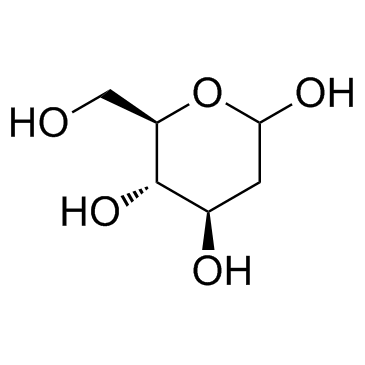2-Deoxy-D-glucose

2-Deoxy-D-glucose structure
|
Common Name | 2-Deoxy-D-glucose | ||
|---|---|---|---|---|
| CAS Number | 154-17-6 | Molecular Weight | 164.156 | |
| Density | 1.4±0.1 g/cm3 | Boiling Point | 456.7±45.0 °C at 760 mmHg | |
| Molecular Formula | C6H12O5 | Melting Point | 146-147ºC | |
| MSDS | Chinese USA | Flash Point | 244.1±25.2 °C | |
|
Autocrine/paracrine function of globular adiponectin: inhibition of lipid metabolism and inflammatory response in 3T3-L1 adipocytes.
J. Cell. Biochem. 116(5) , 754-66, (2015) Adiponectin is an adipose-derived hormone, with beneficial effects on insulin sensitivity and inflammation. The aim of this study was to clarify the autocrine/paracrine effects of globular adiponectin (gAd) administrated during differentiation on the function... |
|
|
Shiga toxin stimulates clathrin-independent endocytosis of the VAMP2, VAMP3 and VAMP8 SNARE proteins.
J. Cell Sci. 128 , 2891-902, (2015) Endocytosis is an essential cellular process that is often hijacked by pathogens and pathogenic products. Endocytic processes can be classified into two broad categories, those that are dependent on clathrin and those that are not. The SNARE proteins VAMP2, V... |
|
|
Lactic acid is a sperm motility inactivation factor in the sperm storage tubules.
Sci. Rep. 5 , 17643, (2015) Although successful fertilization depends on timely encounters between sperm and egg, the decoupling of mating and fertilization often confers reproductive advantages to internally fertilizing animals. In several vertebrate groups, postcopulatory sperm viabil... |
|
|
Activation of mTORC1 in skeletal muscle regulates whole-body metabolism through FGF21.
Sci. Signal. 8 , ra113, (2015) Skeletal muscle is the largest organ, comprising 40% of the total body lean mass, and affects whole-body metabolism in multiple ways. We investigated the signaling pathways involved in this process using TSCmKO mice, which have a skeletal muscle-specific depl... |
|
|
Loss of PHD3 allows tumours to overcome hypoxic growth inhibition and sustain proliferation through EGFR.
Nat. Commun. 5 , 5582, (2014) Solid tumours are exposed to microenvironmental factors such as hypoxia that normally inhibit cell growth. However, tumour cells are capable of counteracting these signals through mechanisms that are largely unknown. Here we show that the prolyl hydroxylase P... |
|
|
Differential effects of AMPK agonists on cell growth and metabolism.
Oncogene 34 , 3627-39, (2015) As a sensor of cellular energy status, the AMP-activated protein kinase (AMPK) is believed to act in opposition to the metabolic phenotypes favored by proliferating tumor cells. Consequently, compounds known to activate AMPK have been proposed as cancer thera... |
|
|
Chenodeoxycholic acid, an endogenous FXR ligand alters adipokines and reverses insulin resistance.
Mol. Cell. Endocrinol. 414 , 19-28, (2015) Adipose tissue secretes adipokines that regulate insulin sensitivity in adipocytes and other peripheral tissues critical to glucose metabolism. Insulin resistance is associated with severe alterations in adipokines characterized by release of increased pro-in... |
|
|
Fluorescence techniques used to measure interactions between hydroxyapatite nanoparticles and epidermal growth factor receptors.
Biotechnol. J. 10(1) , 171-9, (2015) The potential applications of nanomaterials in therapeutics are immense and to fully explore this potential, it is important to understand the interaction of nanoparticles with cellular components. To examine the interaction between nanoparticles and cell mem... |
|
|
Targeting metabolic flexibility by simultaneously inhibiting respiratory complex I and lactate generation retards melanoma progression.
Oncotarget 6 , 37281-99, (2015) Melanoma is a largely incurable skin malignancy owing to the underlying molecular and metabolic heterogeneity confounded by the development of resistance. Cancer cells have metabolic flexibility in choosing either oxidative phosphorylation (OXPHOS) or glycoly... |
|
|
Intracellular Na+ Concentration ([Na+]i) Is Elevated in Diabetic Hearts Due to Enhanced Na+-Glucose Cotransport.
J. Am. Heart Assoc. 4 , e002183, (2015) Intracellular Na(+) concentration ([Na(+)]i) regulates Ca(2+) cycling, contractility, metabolism, and electrical stability of the heart. [Na(+)]i is elevated in heart failure, leading to arrhythmias and oxidative stress. We hypothesized that myocyte [Na(+)]i ... |